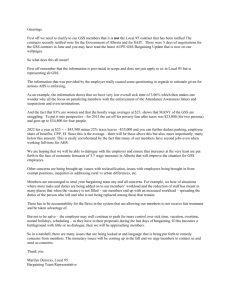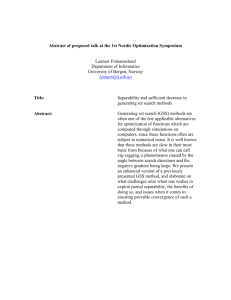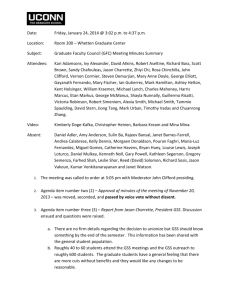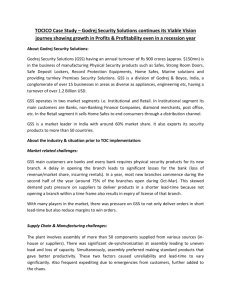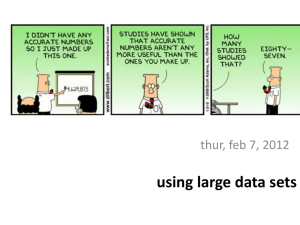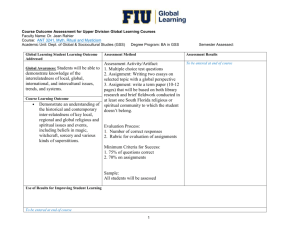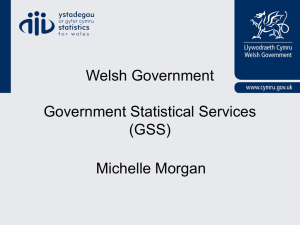2012
advertisement
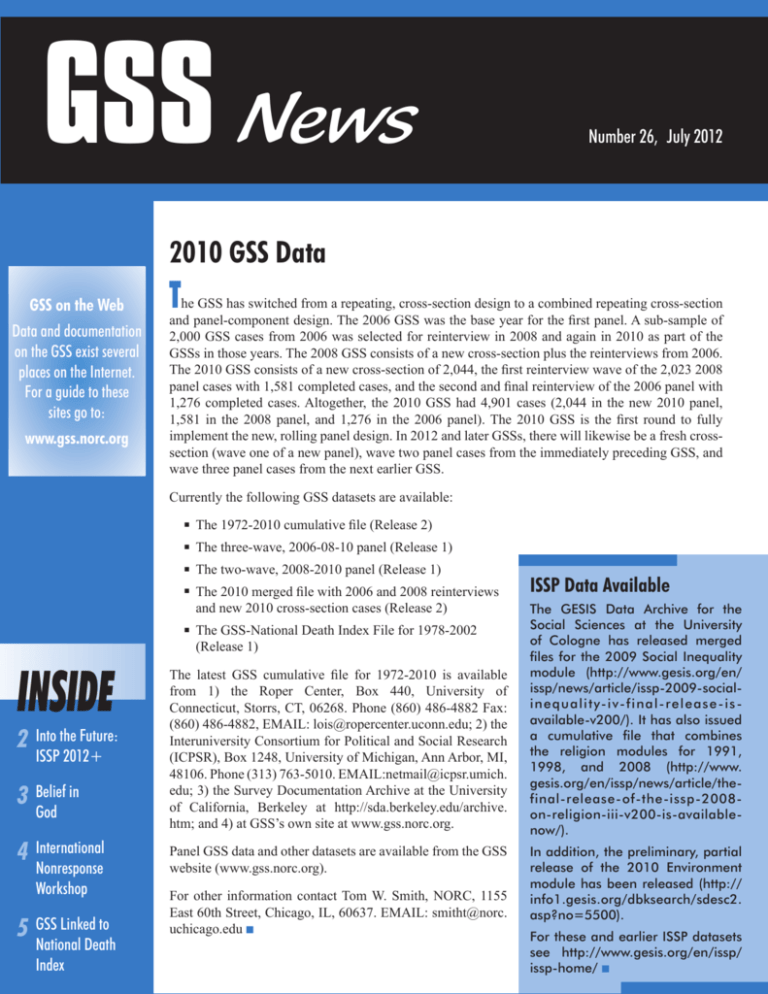
GSS News Number 26, July 2012 2010 GSS Data GSS on the Web Data and documentation on the GSS exist several places on the Internet. For a guide to these sites go to: www.gss.norc.org T he GSS has switched from a repeating, cross-section design to a combined repeating cross-section and panel-component design. The 2006 GSS was the base year for the first panel. A sub-sample of 2,000 GSS cases from 2006 was selected for reinterview in 2008 and again in 2010 as part of the GSSs in those years. The 2008 GSS consists of a new cross-section plus the reinterviews from 2006. The 2010 GSS consists of a new cross-section of 2,044, the first reinterview wave of the 2,023 2008 panel cases with 1,581 completed cases, and the second and final reinterview of the 2006 panel with 1,276 completed cases. Altogether, the 2010 GSS had 4,901 cases (2,044 in the new 2010 panel, 1,581 in the 2008 panel, and 1,276 in the 2006 panel). The 2010 GSS is the first round to fully implement the new, rolling panel design. In 2012 and later GSSs, there will likewise be a fresh crosssection (wave one of a new panel), wave two panel cases from the immediately preceding GSS, and wave three panel cases from the next earlier GSS. Currently the following GSS datasets are available: QQ The 1972-2010 cumulative file (Release 2) QQ The three-wave, 2006-08-10 panel (Release 1) QQ The two-wave, 2008-2010 panel (Release 1) QQ QQ INSIDE 2 Into the Future: ISSP 2012+ 3 Belief in God 4International Nonresponse Workshop 5 GSS Linked to National Death Index The 2010 merged file with 2006 and 2008 reinterviews and new 2010 cross-section cases (Release 2) The GSS-National Death Index File for 1978-2002 (Release 1) The latest GSS cumulative file for 1972-2010 is available from 1) the Roper Center, Box 440, University of Connecticut, Storrs, CT, 06268. Phone (860) 486-4882 Fax: (860) 486-4882, EMAIL: lois@ropercenter.uconn.edu; 2) the Interuniversity Consortium for Political and Social Research (ICPSR), Box 1248, University of Michigan, Ann Arbor, MI, 48106. Phone (313) 763-5010. EMAIL:netmail@icpsr.umich. edu; 3) the Survey Documentation Archive at the University of California, Berkeley at http://sda.berkeley.edu/archive. htm; and 4) at GSS’s own site at www.gss.norc.org. Panel GSS data and other datasets are available from the GSS website (www.gss.norc.org). For other information contact Tom W. Smith, NORC, 1155 East 60th Street, Chicago, IL, 60637. EMAIL: smitht@norc. uchicago.edu ISSP Data Available The GESIS Data Archive for the Social Sciences at the University of Cologne has released merged files for the 2009 Social Inequality module (http://www.gesis.org/en/ issp/news/article/issp-2009-socialinequality-iv-final-release -is available-v200/). It has also issued a cumulative file that combines the religion modules for 1991, 1998, and 2008 (http://www. gesis.org/en/issp/news/article/thefinal-release-of-the-issp-2008on-religion-iii-v200-is-availablenow/). In addition, the preliminary, partial release of the 2010 Environment module has been released (http:// info1.gesis.org/dbksearch/sdesc2. asp?no=5500). For these and earlier ISSP datasets see http://www.gesis.org/en/issp/ issp-home/ Into the Future: ISSP 2011+ A t the annual meeting of the ISSP held in Cavtat, Croatia on April 29-May 2, 2012 the group finalized the content of the 2013 module on the National Identity. For 2014 the topic will be the second fielding of the 2004 Citizenship topic. For 2015 the module will be Work Orientation IV. The United States chaired the National Identity drafting group, Canada and Sweden are chairing the Citizenship drafting group, and Germany will chair the Work Orientation working group. India has joined the ISSP. The 2013 ISSP meeting will be in Santiago, Chile. The ISSP now has 49 countries as members: Argentina Australia Austria Belgium Bulgaria Canada Chile China Croatia Cyprus Czech Republic Denmark Dominican Rep. Estonia Finland France Germany Great Britain Hungary Iceland India Ireland Israel Italy Japan Korea (South) Latvia Lithuania Mexico New Zealand Norway Palestine Poland Portugal Russia Slovakia Slovenia South Africa Spain Sweden Switzerland Taiwan The Netherlands The Philippines The United States Turkey Ukraine Uruguay Venezuela About 5,300 research uses have been documented using ISSP data. A copy of the bibliography is available by contacting the ISSP secretariat or from the ISSP Web site (see below). ISSP documentation and information can be obtained at the following Web sites: http://www.gesis.org/issp/ http://www.issp.org/ 2 Trendlets Belief in God Belief in God has decreased in most countries, but the declines are quite modest especially when calculated on a per annum basis. It is only the repetition of the modest declines across measures and countries that makes the case for a general diminution in belief in God. While the age-group differences suggest the possibility of changes across cohorts that represent larger, more widespread, and longer-term declines in belief in God, these figures confound cohort and aging effects and the analysis suggests that a substantial component of the age-group differences results from aging effects rather than from changes across cohorts. While there is a modest, general shift away from belief in God, there is enormous variation across countries in the level of believers, atheists, and intermediate groups. For example, certitude that God exists ranges from 84% in the Philippines to 4% in Japan and conversely atheism rises from less that 1% in the Philippines to 52% in East Germany. Thus, while there is a drift towards lesser belief in God consistent with secularization theory, the changes are modest in magnitude and mixed in scope. Countries have shown and are likely to continue to show huge differences in levels and trends about belief in God and a homogenization of belief (or disbelief) is unlikely to occur in the foreseeable future. The full report is available from the GSS website (Tom W. Smith, “Beliefs about God across Time and Countries,” GSS Cross-National Report No. 32, January, 2012). General Societal Trends Peter V. Marsden is editor of Social Trends in the United States: Findings from the General Social Survey since 1972, Princeton University Press. The book is being premiered at the American Sociological Association meetings in Denver. It contains the following chapters: QQ QQ QQ QQ QQ QQ Introduction and Overview — Peter V. Marsden On the Seemingly Relentless Progress in Americans’ Support for Free Expression, 1972– 2006 — James A. Davis The Real Record on Racial Attitudes — Lawrence D. Bobo, Camille Z. Charles, Maria Krysan, and Alicia D. Simmons Gender Role Attitudes since 1972: Are Southerners Distinctive? — Karen E. Campbell and Peter V. Marsden Public Opinion in the “Age of Reagan”: Political Trends 1972–2006 — Jeff Manza, Jennifer A. Heerwig, and Brian J. McCabe Crime, Punishment, and Social Disorder: Crime Rates and Trends in Public Opinion over More than Three Decades — James D. Wright, Jana L. Jasinski, and Drew Noble Lanier QQ QQ QQ QQ QQ QQ QQ QQ Trends in Confidence in Institutions, 1973–2006 — Tom W. Smith Continuity and Change in American Religion, 1972–2008 — Mark Chaves and Shawna Anderson Trends in Informal Social Participation, 1974–2008 — Peter V. Marsden and Sameer B. Srivastava Income, Age, and Happiness in America — Glenn Firebaugh and Laura Tach Religion and Happiness — Michael Hout and Andrew Greeley Labor Force Insecurity and U.S. Work Attitudes, 1970s–2006 — Arne L. Kalleberg and Peter V. Marsden Population Trends in Verbal Intelligence in the United States — Duane F. Alwin and Julianna Pacheco Appendix: the General Social Survey Project — Peter V. Marsden and Tom W. Smith Panels A second GSS Methodological Report on the new GSS panels is now available: Michael Hout and Orestes P. Hastings, “Reliability and Stability in 200 Core GSS Items,” GSS Methodological Report No. 119. Chicago: NORC, 2012. This report applies the Heise-Alwin model for estimating reliability and stability measures using the three-wave panel data. Hout is also editing a special issue of Sociological Methods and Research on the GSS panel which should be out in 2013. 3 International Nonresponse Workshop W ith support from NSF, the World Association for Public Opinion Research, and the International Association of Survey Statisticians, the GSS organized the International Workshop on Using Multi-level Data from Sample Frames, Auxiliary Databases, Paradata, and Related Sources to Detect and Adjust for Nonresponse Bias in Surveys was held in Chicago in June, 2011. Its attendees included: QQ Paul Biemer, University of North Carolina QQ J. Michael Dennis, Knowledge Networks QQ Cheryl Eavey, National Science Foundation QQ Robert Groves, US Bureau of the Census QQ Timothy Johnson, University of Illinois, Chicago QQ Dominique Joye, University of Lausanne QQ Jibum Kim, NORC QQ Frauke Kreuter, University of Maryland & Institute for Employment Research QQ Kristin Olson, University of Nebraska QQ Fritz Scheuren, NORC QQ Benjamin J. Skalland, NORC QQ Tom W. Smith, NORC (Organizer) QQ Ineke Stoop, Social and Cultural Planbureau QQ Patrick Sturgis, University of Southampton QQ Roger Tourangeau, University of Maryland The recommendations of that workshop were published in Smith, Tom W. “The Report on the International Workshop on Using Multi-level Data from Sample Frames, Auxiliary Databases, Paradata, and Related Sources to Detect and Adjust for Nonresponse Bias in Surveys,” International Journal of Public Opinion Research, 23 (2011), 389-402. Occupational and Industry Coding Studying the role of occupation and industry in American society is complicated by the changing nature of the work force and how occupations and industries are coded. The GSS used the 1970 Census classification of occupations and industries to code the 1972-1990 GSSs and the 1980s Census classifications to code 1988-2010.The 1988-1990 GSSs were dual coded. With support from NSF the GSS is in the process of retrieving old cases from 1972-2010, data entering the verbatim answers to the occupation/industry questions, and coding all cases according to the 2007 North American Industrial Classification System and the 2010 Census classification of occupations. The new 2012 GSS cases will be similarly coded. This will mean that all GSS cases are coded to one standard and that it covers the latest developments in occupations and industries. It is expected that the new codes will be available in early 2013. 4 GSS Linked to National Death Index The newly constructed GSS-NDI (General Social Survey – National Death Index) dataset allows social epidemiologists to better understand how social factors—ideas, attitudes, beliefs, relationships, and actions—affect health. It links records from the 1978 through 2002 waves of the General Social Survey to death records through 2008 from the National Death Index. The GSS-NDI dataset contains 32,830 total records, of which 9,271 have been classified as deceased. The GSS-NDI also contains information on the primary cause of death for each deceased participant using the single-level Clinical Classification Software (CCS) system (in addition to the original ICD-9 and ICD-10 coding). Creation of the GSS-NDI was funded by a grant provided by the National Institute on Minority and Health Disparities (NIMHD), and details regarding the construction of the dataset are in “The General Social Survey-National Death Index: An Innovative New Dataset for the Social Sciences,” BMC Research Notes, 4 (2011), 385ff. The dataset is available from the GSS website. Acquiring Sensitive Data Contextual analysis utilizing aggregate-level data can be very valuable for understanding human societies. The GSS can provide restricted data that include state, primary sampling unit, county, and Census tract information. However, the GSS requires that all information that might identify respondents to the survey be kept secure, and thus the GSS requires a formal application process be followed to obtain sensitive data. Any request for GSS information must include a research plan, Curriculum Vitae for all members of the project, a human subjects review clearance, and a Sensitive Data Protection Plan which will describe how the data will be handled. This includes identifying all persons who will have access to information and how they will be able to access the information. A description of where the data will be physically located (including where removable drives will be kept) must be included as well as the exact ways in which the system the data will be processed on is secured. A plan for how duplication of data, including automatic backing up of files, will be prevented as well as how printing out the data will be restricted. The GSS also requires that all results derived from the data it provides be treated with the same level of security as that which applies to the data given by the GSS in first place. Once all application materials are approved, a contract for the use of sensitive data will be established for all relevant parties. For further details on GSS requirements regarding this issue, including necessary fees, please see the following: http://publicdata.norc.org:41000/gss/documents//OTHR/ObtainingGSSSensitiveDataFiles.pdf General Social Survey NORC, A Social Science Research Center 1155 East 60th Street Chicago, Illinois 60637 5
